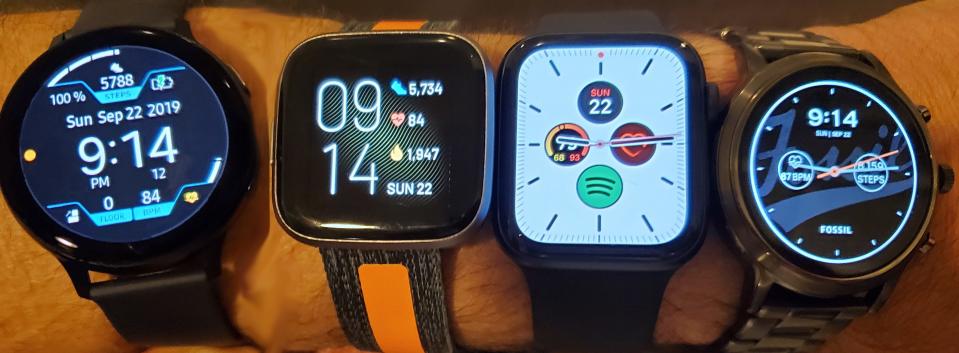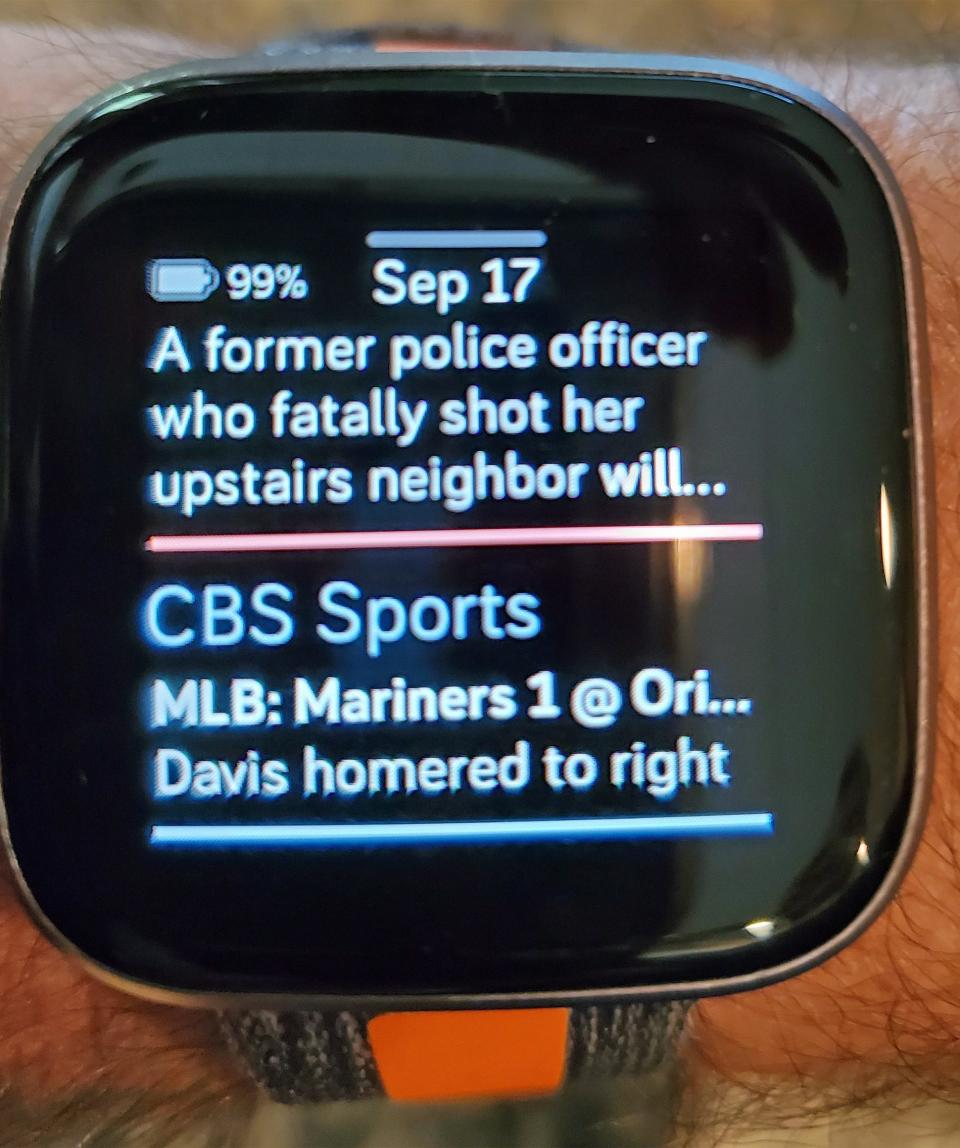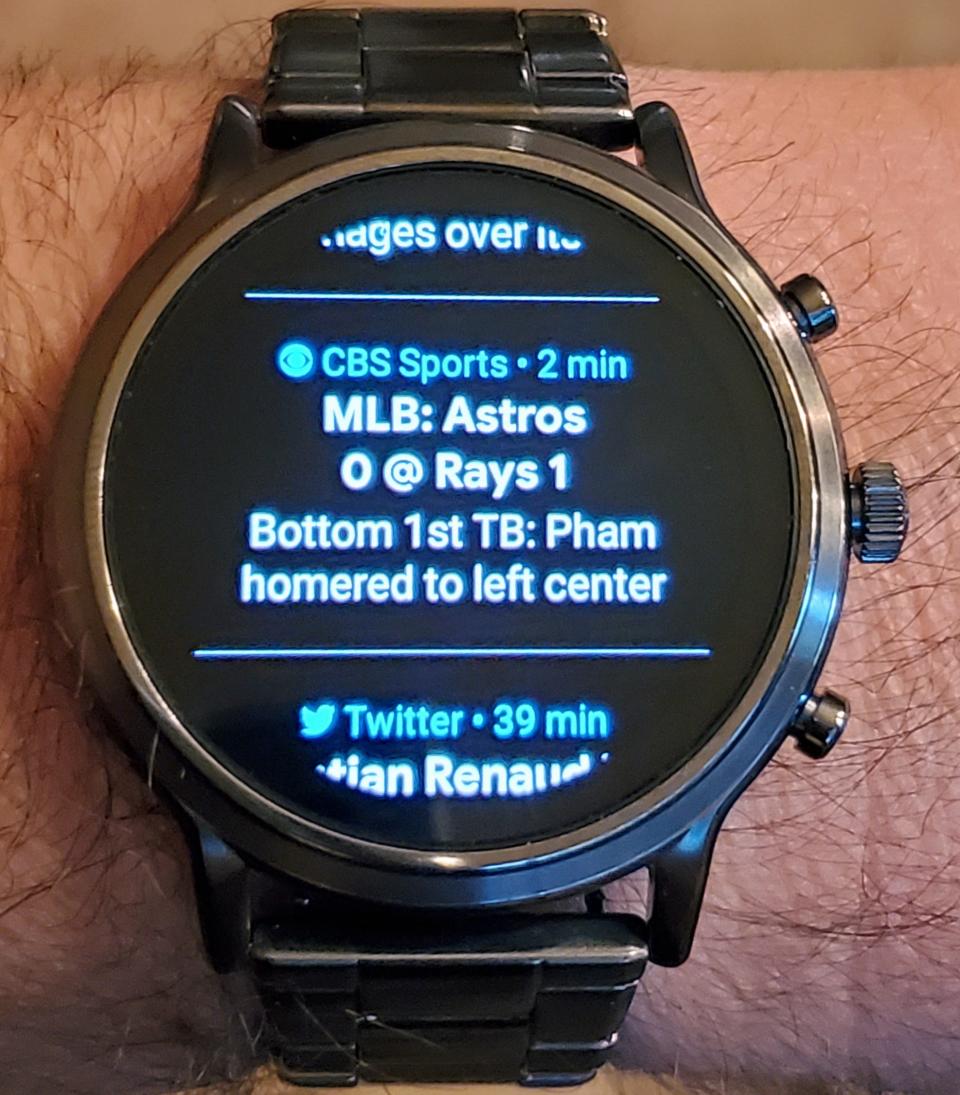Apple, Fitbit, Fossil, Samsung: How to choose the right smartwatch
SCOTTSDALE, Ariz. – Psst … looking for a great deal on a smartwatch? Then, this may turn out to be just the season.
Indeed, the theme for this year’s crop of full-featured wearables is less about driving new capabilities, as it was last year, and more about packing the latest technology into lower price points. Apple did introduce the Apple Watch Series 5 at its traditional premium price points of $399 and $499. But in announcing the Series 5, the market leader also acknowledged the growing value segment by dropping the price of the Series 3 watch to $199 for the GPS version and $299 for cellular.
Fitbit and Samsung, the next two largest smartwatch suppliers in the U.S., both stood pat on their premium lines and instead targeted mainstream price points with new products: Fitbit’s Versa 2 at $199, and the $299 Active2 from Samsung.
All of this is not only good news for your wallet today. It’s also a sign that the parade of new technology is slowing, which means you won’t feel like the watch you bought this season will be obsolete the next.

I’ve been evaluating all three suppliers’ newest devices, as well as the Gen 5 Carlyle from Fossil, Google’s leading partner on the Wear OS, priced at $295.
Here’s my take:
Apple Watch Series 5
The Series 5 is certainly a handsome, compelling smartwatch. That said, the enhancements over the Series 4 pale in comparison to the leap last year’s model made over the Series 3. Which probably explains why Apple maintained the Series 3 as its entry-level option and pulled the Series 4.
One nice thing: Although the Series 5 maintains the brand’s signature soft-rectangular styling, it’s never been easier to pick out the new Watch from a wrist in a lineup. Thank the new always-on display for that.
The always-on feature also sets the Series 5 apart from the smartwatches reviewed here. It displays a white-on-mostly-black version of the watch face you’ve selected and is even readable in the bright Arizona sun. The others all have an always-on option as well. But they offer either similar outdoor viewability or watch-face flexibility, but not both.
The company added two more hardware features. One is an integrated compass. It works well and would no doubt come in handy for in-the-wild activities like off-the-path hiking.
The other is international emergency calling, a no-borders extension of the SOS feature from earlier Watches. That, along with fall detection and built-in ECG from the Series 4, is helping appeal to older consumers who haven’t shown as much interest in smartwatches as younger buyers.
As with all Apple Watches, the Series 5 is elegant, capable and user-friendly. Notifications, for example, often pull more media and formatting from the original phone alert than the others. Like my CBS Sports alerts, which display accompanying photos on the Apple Watch but not the other devices.
Sleeping on the job? New Apple Watch, but still no sleep tracking
The Health app incorporates a few metrics others also offer, like high and low heart rate and resting heart rate – which I find to be particularly valuable for gauging fitness levels over time. And of course, Apple is still alone in offering apps with irregular heart rate detection and companion ECG.
Certainly, Apple is a leader in the health space in many ways. Which is why it’s so surprising that neither Apple nor third-party developers have advanced sleep-quality assessment beyond motion detection. To add more advanced quality metrics, Apple would need to incorporate heart rate. It’s not for lack of quality sensing.
I suspect it has more to do with battery life, which is on par with previous generations at 18 hours. Samsung and Fitbit didn’t start to incorporate more sophisticated sleep tracking until they began offering smartwatches with multiday battery life one and two years ago, respectively. Maybe the same will happen soon at Apple.
Fitbit Versa 2
Though Fitbit is a pioneer in the fitness tracker space, it’s a relative newcomer to smartwatches, introducing its first just two years ago. That product, the Fitbit Ionic, is still available, for $249.
Rather than refreshing the Ionic, Fitbit has since followed with more mainstream products at the $199 price point: the Versa in 2018, and, this season, the Versa 2. With the Versa 2, the company also cut the price of the Versa Lite, a lower-cost spinoff of the original, to $159.
You can read my full review of the Versa 2, but briefly: It’s a compelling follow-on, with a much-improved screen and even better battery life. It draws from Fitbit’s heritage in fitness tracking and, as such, is still the best at offering detail and insight into exercise, fitness and sleep. I find Fitbit’s new Sleep Score feature to be a compelling enhancement.
That said, the health gap between Fitbit and the others is closing. Samsung has made great strides and Apple, as mentioned, is also forging ahead.
Before Apple Watch, there was Fitbit: A decade of tracking our steps
What makes Fitbit increasingly vulnerable is that, with its fitness edge slimming, it’s not keeping up with the smartwatch-first suppliers on, you know, the smartwatch stuff.

The Versa 2, for example, is now the only device in the price range without a built-in speaker or GPS. Fitbit did integrate Amazon’s Alexa, and added a microphone interface. The microphone is off by default, so you must press and hold the side button to activate. I view that more as a feature than a bug, for privacy's sake. And the lack of a speaker doesn’t bother me. I’m content to read Alexa’s responses on the display – especially in crowded areas.
Other smartphone-style efforts are similarly lacking. The new Spotify app, for example, is little more than a play/pause/forward/rewind remote. The Spotify apps on the other three smartwatches all offer far more.
And while the always-on screen is viewable outdoors, the Versa 2 displays little more than the time. And the only way to wake the watch is to press the side button.
Aesthetically, calendar alerts, call notifications and other flags on the Versa 2 are the weakest of the group. In stark contrast to the Apple Watch’s pristine alerts, for example, the CBS Sports updates often truncate the score, so I usually see only the visiting team’s score, as it’s listed first.
If your primary interest is health, fitness and sleep, then all of this is small change. The Versa 2 is worth your attention.
Fossil Gen 5
The Fossil Gen 5 – particularly the Carlyle model with the stainless-steel band I was sent for evaluation – is without a doubt a masculine watch.
It’s weighty and formidable. Like a real watch. The screen is also handsome. The interface is clean and friendly. Navigation is straightforward. Notifications are attractive. The Gen 5 works well. Which is saying something for Wear OS by Google watches.

But I’ve found the watch to be equal parts frustrating and satisfying. The display is the faintest of the watches here. During initial setup, in fact, the screen was so dim I could barely read the prompts. I suspect that has something to do with managing battery life, which consistently was the poorest of the bunch. Sometimes the Carlyle lasted just 12 hours. It never stretched beyond 20.
There are other battery-sparing tricks employed. The watch only samples heart rate once every 20 minutes, for example, unless you’re exercising. And it doesn’t monitor sleep using heart rate, only motion. At least, I couldn’t find an app that uses heart rate for sleep.
So, apps. If you assumed an open smartwatch platform with multiple hardware vendors would boast one of the richest suites of apps, well, you know what happens when you assume. The Wear OS library doesn’t come close to approaching the depth and breadth of either Apple’s or Samsung’s. Even Fitbit, the relative newcomer, has more to choose from.
And yet, frustrating as the Gen 5 can be, I still like it. It’s hard to explain, I know. It’s just a really nice, solid watch. And what works, works pretty well.
Samsung Galaxy Watch Active2
The new Samsung Galaxy Watch Active2 doesn’t have quite as rich a fitness and health suite or as long a battery life as the Versa 2. But it’s close. Neither does it have quite as elegant a user interface or feature-packed hardware as the Apple Watch Series 5. But again, it’s close.
But who’s complaining? It’s packed with features. It does just about everything both fitness-first and smartwatch-centric competitors do. It even has built-in cellular. And it costs $299 for the larger, 44mm version (40mm, $279), just $100 more than the Versa 2 – and $200 less than the cellular-enabled Apple Watch Series 5.
Now, you might wonder why Samsung released the Active2 just six months after coming out with the original Active. Because Samsung didn’t replace the original. It’s selling both devices, the former at $199, $100 less than the Active2.
The source of the confusion is the generational designation. I might have called it something like the Active XL, or Active Ultra. But whatever.
In addition to incorporating cellular capability, Samsung also doubled the number of heart rate sensors, to eight, a move no doubt designed to help improve accuracy. In my tests, I did notice a difference in the Active2’s ability to maintain continuous readings, even with my wrist contorted in ways that let more ambient light flood in under the watch face. It also managed to log sleep stages during a couple nights that, for whatever reason, the Versa 2 could not.

Samsung recently upgraded its smartwatch interface, and notifications, as well as the overall look and feel, are more attractive and friendly than before – though still not quite up to the Apple Watch standard, or even Wear OS.
Perhaps the biggest need for improvement: The Active2 is long on health data yet comparatively short on insight. That’s improving, though it is still an area where Fitbit remains the clear winner.
The envelope, please …
And the winner … well, that depends on what you want out of a smartwatch.
Hopefully, by now, there is enough difference in form, function and price that your device-to-be is calling your name. (Unless it’s the Versa 2, which doesn’t have a speaker. Sorry.) But just in case:
•If you have an iPhone, you want a premium, full-featured performer with a few extras – and, oh, and by the way, you already know how well you sleep, thank you very much – then consider the Apple Watch Series 5
•If an abundance of health and fitness insights above all else is really what you’re after, then select the Fitbit Versa 2
•If what you’re after is a really nice watch with enough battery and smarts to get you through the day, then take a hard look at the Fossil Gen 5, and
•If you like a lot of health and fitness data to help draw your own conclusions, you care about sleep, and you’d really like to leave your phone behind sometimes when you walk the dog or go for a run, then check out the Samsung Active2.
But most importantly, if what you want is a smartwatch that will sit on your wrist for a few years before it starts showing its age, then you can’t go wrong with any of these.
USA TODAY columnist Mike Feibus is president and principal analyst of FeibusTech, a Scottsdale, Arizona, market research and consulting firm, and producer of Privacy Now, a twice-monthly interview series on YouTube. Reach him at mikef@feibustech.com. Follow him on Twitter @MikeFeibus.

This article originally appeared on USA TODAY: Apple, Fitbit, Fossil, Samsung: Choosing the right smartwatch for you

